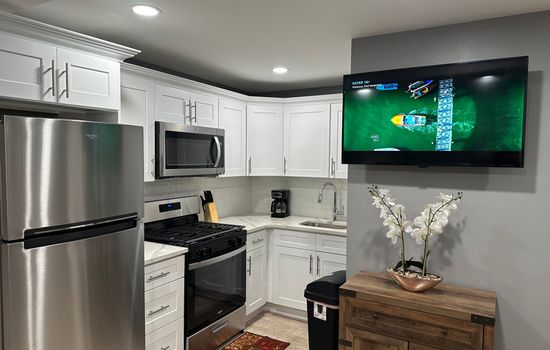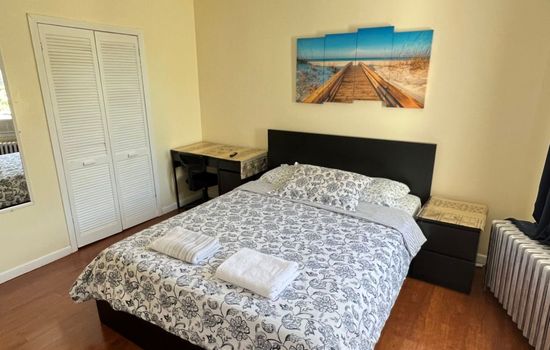The visitor center at the Lower East Side Tenement Museum is open Sunday through Thursday from 10:00 AM to 5:30 PM, and Friday and Saturday from 10:00 AM to 6:00 PM.
The entrance fee at the Lower East Side Tenement Museum is $30 per person for adults. Members and certain groups, such as teachers, military, and neighborhood residents, receive discounts. Members enter for free.
From Manhattan, take the F, J, M, or Z subway to Grand Street or Delancey Street. Walk east on Grand or west on Delancey to Orchard Street, immersing yourself in the historic Lower East Side neighborhood.
No onsite parking available. Limited metered street parking, no RVs or overnight parking. No parking fees mentioned.
Accessibility & permits
Emergency
- Cell service availability:Partial
Information not accurate?
Help us improve by making a suggestion.
In the heart of Manhattan’s Lower East Side, the Lower East Side Tenement Museum stands as a poignant testament to the immigrant experience, a National Historic Site that embodies the vibrant tapestry of American history. Located at 97 and 103 Orchard Street, these two historic tenement buildings, constructed in 1863, once housed an estimated 15,000 people from over 20 nations.
As you step into the meticulously restored family apartments, you are enveloped by the stories of countless families who called this place home. The Italianate architectural style of the buildings, with their ornate facades and narrow stairways, transports you to a bygone era. Guided tours weave through the cramped yet resilient living spaces, offering a glimpse into the daily lives of immigrants who shaped the city.
The museum’s surroundings are just as compelling, with the bustling streets of the Lower East Side offering a diverse culinary and cultural experience. Nearby, the historic Orchard Street teems with vintage shops and eclectic eateries, reflecting the neighborhood’s enduring spirit.
Seasonal programs and events further enrich the experience. From neighborhood walking tours that highlight the area’s rich history to special exhibitions that delve into the lives of its former residents, there is always something new to discover. The museum also hosts various educational programs, including those tailored for K-12 students, ensuring that the legacy of these immigrants continues to inspire future generations.
For those seeking a deeper connection to the past, the museum’s affiliation with the National Park Service and its partnership with Ellis Island provide a comprehensive look at the immigrant journey. Whether you are drawn to history, architecture, or the vibrant culture of New York City, the Lower East Side Tenement Museum is an immersive destination that will leave you with a profound appreciation for the human spirit and the enduring impact of immigration on American society.
- Area (mi²)
- 1
- Annual visitors
- 225 000
- Established year
- 1988
Top 3 Facts about Lower East Side Tenement National Historic Site
The historic tenement buildings, constructed in 1863, initially contained 22 apartments and a basement-level saloon. Over time, modifications included the installation of indoor plumbing with two toilets per floor, an air shaft, and the transition from gas to electricity. By 1935, the upper floors were sealed, leaving only the stoop-level and basement storefronts open, preserving the building as a time capsule of 19th and early 20th-century living conditions. Some upper floors remain unstable and closed due to this preservation.
In the heart of a historic urban landscape, a different kind of ecosystem thrives. While the area is predominantly known for its human history, the surrounding environment is home to a variety of urban wildlife. Look for pigeons and squirrels scampering through the streets, and if you’re lucky, spot a red-tailed hawk soaring overhead. The nearby waterways occasionally host migratory birds and fish, adding a touch of natural beauty to this vibrant neighborhood. The urban flora, though often overlooked, includes hardy street trees and resilient garden plants that thrive amidst the bustling city life. This unique blend of history and urban wildlife makes for a fascinating and immersive experience.
In the midst of Manhattan’s bustling streets, the Hudson River flows just a few miles west, its waters a deep blue-grey that reflect the city’s ever-changing skies. The river’s tidal currents create a unique marine ecosystem, with water temperatures ranging from near-freezing in winter to warm in the summer, supporting a diverse array of marine life. This urban waterfront offers a stark contrast to the historic tenements, a blend of natural and human-made landscapes that define the city’s essence.
Family programs
- Ranger-led Tours
- Workshops & Hands-on Activities
- Living History & Cultural Demos
- Scavenger Hunts
- Virtual Junior Activities
- Arts & Crafts
Travel Tips
Plan Ahead
Visit in spring for the Lower East Side Festival. Plan for an afternoon, with guided tours lasting 1-2 hours. Arrive at the Delancey Street entrance, where wheelchair accessibility is available. Wear comfortable shoes for neighborhood walking tours and consider nearby dining options.
Pack Appropriately
Pack a lightweight backpack with water, snacks, sunscreen, a hat, and layers for changing weather. Include a camera, spare cash, and a small first aid kit for a seamless day trip. Check the forecast to add a rain jacket or umbrella if necessary.
Respect Wildlife
In this urban historic site, respect the local environment by disposing of waste properly and avoiding single-use plastics. Support local green initiatives and maintain a clean footprint to preserve the area for future visitors. Be mindful of urban wildlife and keep noise levels down to minimize disruption.
Stay Informed
Stay on designated trails, avoid ledges and water areas. Check weather conditions and fire restrictions. For emergencies, call 911 or park authorities at 212-431-0233.
Seasons
Visit in spring (March to May, 40s-60s°F) for mild weather and exclusive Thursday night tours, including the new “Life and Death” tour, starting in October but available through spring. Immerse in historic immigrant stories amidst blooming city streets.
Explore historic tenements and vibrant neighborhoods in the sweltering New York summer (June to August, 80s-90s°F). Catch special events and walking tours, including the award-winning podcast-inspired programs. Despite the heat, summer offers unique immersive experiences and behind-the-scenes insights into immigrant lives.
Visit in fall, when crisp temperatures (50s-60s°F) and golden light enhance the historic charm. Thursday nights, from October, enjoy exclusive after-hours tours and programs, including the new “Life and Death” tour. A must for those seeking immersive experiences.
Explore historic tenements from December to February, amidst NYC’s chilly winter (25-45°F). Crisp air enhances the gritty charm of 19th-century immigrant life, making for a poignant and immersive visit.
Information not accurate?
Help us improve by making a suggestion.
Where to stay
Frequently Asked Questions
Ready to dive into what Lower East Side Tenement National Historic Site has to offer? Let’s tackle some of the burning questions you might have as you plan your visit!
-
You should stay in New York City to visit this historic site, which is located at 97 and 103 Orchard Street on the Lower East Side of Manhattan. This area was home to an estimated 15,000 people from over 20 nations between 1863 and 1935.
-
Pets are not allowed inside the tenement buildings, but service dogs are welcome on all tours. Emotional support animals are also not permitted inside the buildings.
-
There is no dedicated parking at the site, but you might find parking in nearby garages or street parking, especially on weekends. However, parking can be limited and is not guaranteed. Public transportation is recommended.
-
The Lower East Side Tenement Museum is based in two historic buildings, 97 and 103 Orchard Street, which were home to around 15,000 immigrants from over 20 nations between 1863 and 1935. The building at 97 Orchard Street was constructed by Prussian-born immigrant Lukas Glockner in 1863 and underwent several modifications to comply with New York State housing laws. After being abandoned and sealed in 1935, the building was restored starting in 1988 by founders Ruth J. Abram and Anita Jacobson, and it was designated a National Historic Landmark in 1994.



